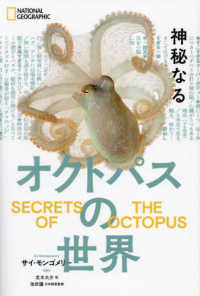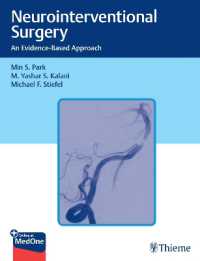Full Description
The presence of sophisticated auditory processing in mammals has permitted perhaps the most significant evolutionary development in humans: that of language. An understanding of the neural basis of hearing is thus a starting point for elucidating the mechanisms that are essential to human communication. The cochlear nucleus is the first region of the brain to receive input from the inner ear and is therefore the earliest stage in the central nervous system at which auditory signals are processed for distribution to higher centers. Clarifying its role in the central auditory pathway is crucial to our knowledge of how the brain deals with complex stimuli such as speech, and is also essential for understanding the central effects of peripheral sensorineural hearing loss caused by, for example, aging, ototoxic drugs, and noise. Ambitious new developments to assist people with total sensorineural deafness, including both cochlear and cochleus nuclear implants, require a detailed knowledge of the neural signals received by the brainstem and how these are processed. Recently, many new data have been obtained on the structure and function of the cochlear nucleus utilizing combinations of anatomical, physiological, pharmacological and molecular biological procedures. Approaches such as intracellular dye-filling of physiologically identified neurons, localization of classical neurotransmitters, peptides, receptors and special proteins, or gene expression have opened the door to novel morphofunctional correlations.
Contents
The cellular basis for signal processing in the mammalian cochlear nuclei.- I. Developmental Issues.- Cell birth, formation of efferent connections, and establishment of tonotopic order in the rat cochlear nucleus.- Postnatal development of auditory nerve projections to the cochlear nucleus in Monodelphis Domestica.- II. Primary Inputs.- Anatomical and physiological studies of type I and type II spiral ganglion neurons.- Topographic organization of inner hair cell synapses and cochlear spiral ganglion projections to the ventral cochlear nucleus.- Ultrastructural analysis of synaptic endings of auditory nerve fibers in cats: correlations with spontaneous discharge rate.- III. Intrinsic Connections.- Intrinsic connections in the cochlear nuclear complex studied in vitro and in vivo.- The synaptic organization of the ventral cochlear nucleus of the cat: the peripheral cap of small cells.- Alterations in the dorsal cochlear nucleus of cerebellar mutant mice.- IV. Descending Projections.- Non-cochlear projections to the ventral cochlear nucleus: are they mainly inhibitory?.- Non-primary inputs to the cochlear nucleus visualized using immunocytochemistry.- Superior olivary cells with descending projections to the cochlear nucleus.- Descending projections from the inferior colliculus to the cochlear nuclei in mammals.- V.- Neurotransmitters of the Cochlear Nucleus.- Localizing putative excitatory endings in the cochlear nucleus by quantitative immunocytochemistry.- Excitatory amino acid receptors in the rat cochlear nucleus.- Glycine and GABA: transmitter candidates of projections descending to the cochlear nucleus.- Inhibitory amino acid synapses and pathways in the ventral cochlear nucleus.- Glycinergic inhibition in the cochlear nuclei: evidence for tuberculoventral neuronsbeing glycinergic.- GABA and glycine inputs control discharge rate within the excitatory response area of primary-like and phase-locked AVCN neurons.- Neuropharmacological and neurophysiological dissection of inhibition in the mammalian dorsal cochlear nucleus.- Comparison of quantitative and immunohistochemistry for choline acetyltransferase in the rat cochlear nucleus.- Choline acetyltransferase in the rat cochlear nuclei: immunolocalization with a monoclonal antibody.- VI. Projections and Response Properties of Cochlear Nucleus Neurons.- The cochlear root neurons in the rat, mouse and gerbil.- Projections of cochlear nucleus to superior olivary complex in an echolocating bat: relation to function.- The monaural nuclei of the lateral lemniscus: parallel pathways from cochlear nucleus to midbrain.- Ascending projections from the cochlear nucleus to the inferior colliculus and their interactions with projections from the superior olivary complex.- Responses of cochlear nucleus cells and projections of their axons.- Physiology of the dorsal cochlear nucleus molecular layer.- Coding of the fundamental frequency of voiced speech sounds and harmonic complexes in the cochlear nerve and ventral cochlear nucleus.- VII. Computer Modelling of the Cochlear Nucleus.- Computer modelling of the cochlear nucleus.- Regularity of discharge constrains models of ventral cochlear nucleus bushy cells.- Cross-correlation analysis and phase-locking in a model of the ventral cochlear nucleus stellate cell.- VIII. Appendix: Cochlear Nucleus Prostheses.- The development and evaluation of cochlear nucleus prostheses.- IX. Special Contributions in Honour of R. Lorente de Nó.- Lorente de Nó's scientific life.- Sensoritopic and topologic organization of the vestibular nerve.- Lorente de Nóand the hippocampus: Neural modeling in the 1930s.- The rat entorhinal cortex. Limited cortical input, extended cortical output.- Axonal patterns of interneurons in the cerebral cortex: in memory of Rafael Lorente de Nó.- Glomérulos, barrels, columns and maps in cortex: an homage to Dr. Rafael Lorente de Nó.- Lorente de Nó: the electrophysiological experiments of the latter years.








